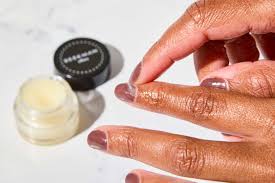
5 Dermatologist-Approved Alternatives to Cuticle Oil You Can Use Today
Cuticles are an often overlooked part of our hands, though they play an essential role in protecting the skin around our nails.
Many people only notice their cuticles when they become dry, cracked, or painful.
This dryness can arise due to several reasons, including environmental factors like cold weather, frequent hand washing, or exposure to UV light from nail dryers, says Dr. Anna Guanche, a board-certified dermatologist.
Additionally, certain medical conditions such as eczema or psoriasis may cause the cuticles to become inflamed or damaged, according to dermatologist Dr. Onyeka Obioha.
Cuticle oil has become the most popular and effective way to treat dry, irritated cuticles.
Dr. Rina Weimann, a board-certified dermatologist, explains that cuticle oils serve two main functions:
Hydrating the cuticles to keep them soft, and forming a protective barrier against further irritation from harsh chemicals or environmental factors.
But what if you don’t have cuticle oil readily available? Don’t worry.
We consulted these experts to identify some dermatologist-approved alternatives that can provide similar benefits and help maintain your nail health without needing a special bottle of cuticle oil.
Keep reading to discover five accessible and effective substitutes you can use to nourish your cuticles and keep your nails looking their best.
1. Vitamin E: A Versatile and Nourishing Option
Vitamin E is a common ingredient in many commercial cuticle oils, and it’s easy to understand why. Dr. Weimann highlights that vitamin E helps to soften and hydrate the cuticle area effectively.
Moreover, Dr. Obioha points out that vitamin E not only moisturizes but also promotes nail regeneration and strengthens the nails themselves, encouraging healthier growth over time.
One of the simplest ways to incorporate vitamin E is by using olive oil, which contains natural vitamin E and is something most people already have in their kitchens.
Vitamin E is also conveniently available in capsule form. You can easily break open these capsules and apply the oil directly to your cuticles, making it a handy option for on-the-go care.
Regular application can soothe dry, cracked cuticles and provide much-needed nourishment without the need for a specialized product.
2. Lanolin: The Moisture-Locking Emollient
Lanolin is a natural substance well-known for its ability to lock moisture into the skin.
Dr. Obioha praises lanolin for its emollient properties, which not only prevent dryness but also help promote smooth, healthy nail regrowth.
This makes lanolin an excellent choice for anyone experiencing brittle or damaged cuticles. It works by forming a protective layer on the skin, which helps to retain hydration for extended periods.
Beyond its benefits for nails, lanolin is also widely used in skincare for lips and even for soothing sore nipples during breastfeeding.
This versatility means that lanolin can serve multiple purposes in your personal care routine, making it a practical and multi-functional ingredient to keep around.
3. Avocado Oil: Rich in Healthy Fats
Avocado oil is another fantastic alternative that dermatologists recommend for treating dry cuticles.
Dr. Guanche appreciates avocado oil for its natural, organic qualities and its high content of monounsaturated fats.
These healthy fats are crucial for repairing and softening dry, damaged skin around the nails.
If you’re someone who prefers to use natural ingredients, avocado oil is a wonderful addition to your cuticle care routine.
A major advantage of avocado oil is its accessibility.
Since many people already keep it in their kitchens for cooking or salads, it can be an easy substitute without requiring you to purchase a special product.
According to Dr. Guanche, some people apply avocado oil every time they wash their hands to maintain cuticle hydration, but the frequency is really a personal choice.
Experiment to see what works best for you.
4. Coconut Oil: Hydrating and Anti-Inflammatory
Coconut oil has long been a staple in skincare and haircare, and it’s equally effective for your nails and cuticles.
Dr. Weimann highlights that coconut oil doesn’t just hydrate but also has anti-inflammatory properties that can calm skin irritation and reduce redness.
This is especially beneficial if your occupation involves frequent hand washing or exposure to chemicals, which can lead to dry, split cuticles.
People working as hairdressers, healthcare professionals, mechanics, or others who regularly clean their hands may find coconut oil particularly helpful.
It helps to restore the skin barrier and soothe inflammation caused by repeated exposure to irritants. Applying coconut oil to your cuticles can prevent damage and keep them looking healthy and polished.
5. Hyaluronic Acid: A Hydration Powerhouse
If you enjoy skincare products, you’re probably familiar with hyaluronic acid (HA) as a powerful moisturizer.
Dr. Obioha explains that hyaluronic acid is effective at drawing hydration into the cuticles and nails.
Unlike oils, HA is water-based, making it light and easy to apply without feeling greasy or heavy on the skin.
Hyaluronic acid is especially beneficial because it can be applied frequently without causing buildup.
Dr. Obioha recommends using it multiple times daily—up to three times or even after every hand wash—to maintain optimal hydration.
Because of its quick absorption and non-oily texture, HA is an excellent substitute for traditional cuticle oils, particularly for those who prefer lighter products.
Dry cuticles are more than just a cosmetic issue; they can be painful and make your hands appear less polished.
While cuticle oils are a great go-to for treating dry skin around your nails, the substitutes listed here offer accessible, dermatologist-approved alternatives that you may already have at home.
Vitamin E, lanolin, avocado oil, coconut oil, and hyaluronic acid all deliver essential hydration and nourishment to your cuticles, helping them stay healthy and strong.
By incorporating one or more of these alternatives into your routine, you can keep your cuticles moisturized and prevent painful cracks or peeling.
Many of these ingredients also promote healthier nail growth, meaning your nails will not only look better but become stronger over time.
Whether you prefer oils rich in natural fats or lighter, water-based serums, there’s an option here to fit your lifestyle and preferences.
So next time your cuticles feel dry and irritated but you’re out of cuticle oil, don’t panic.
Reach for one of these dermatologist-recommended substitutes and enjoy healthier, happier nails with just a few simple steps.
Consistency is key, and by giving your cuticles the care they deserve, you can maintain beautiful, well-groomed hands year-round.


